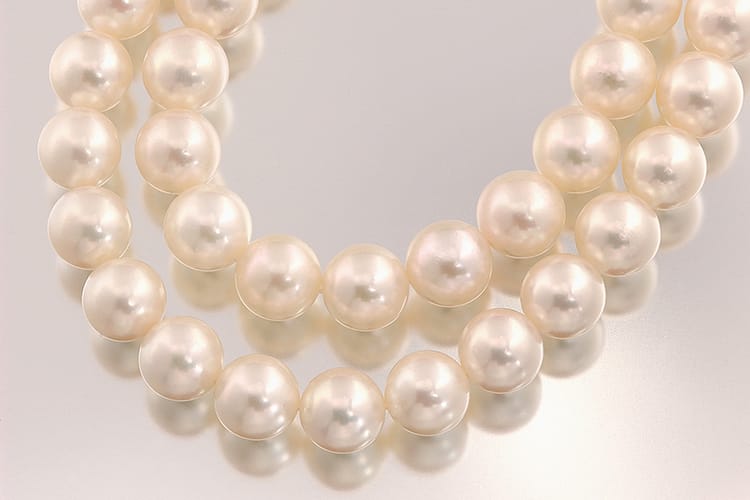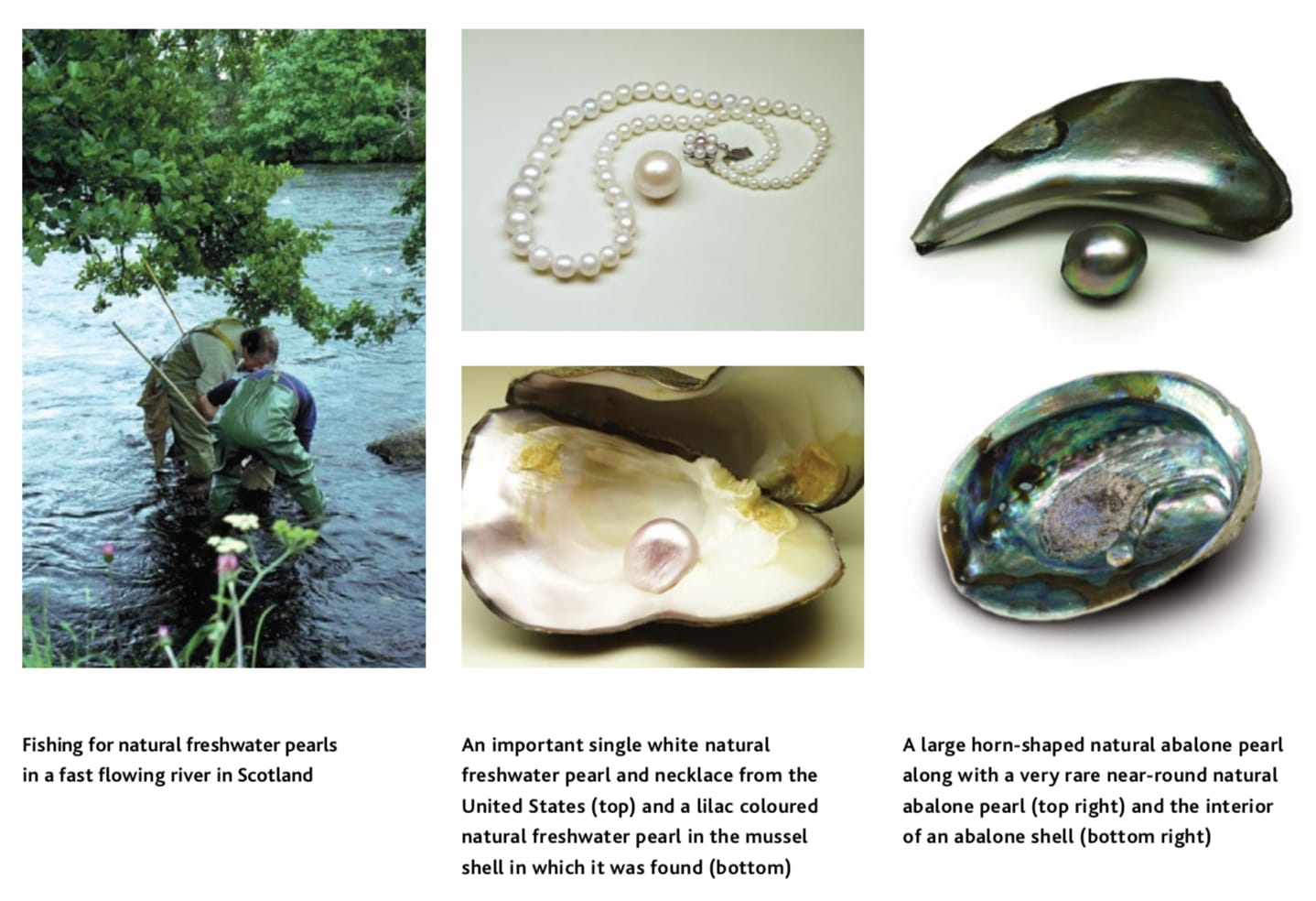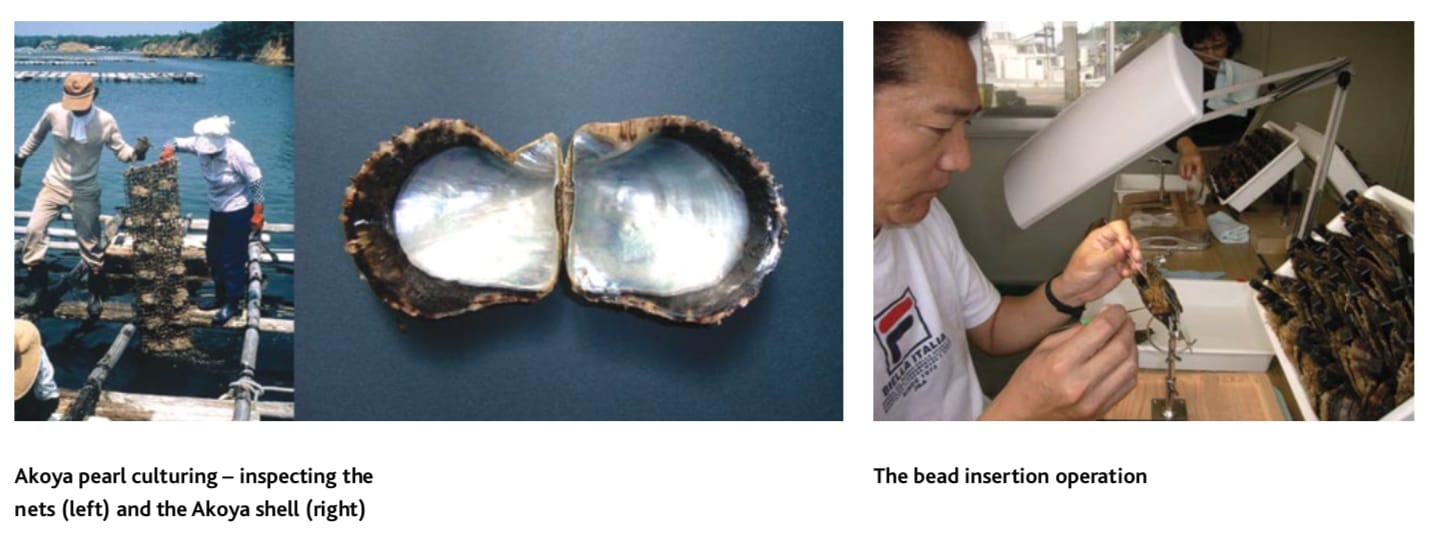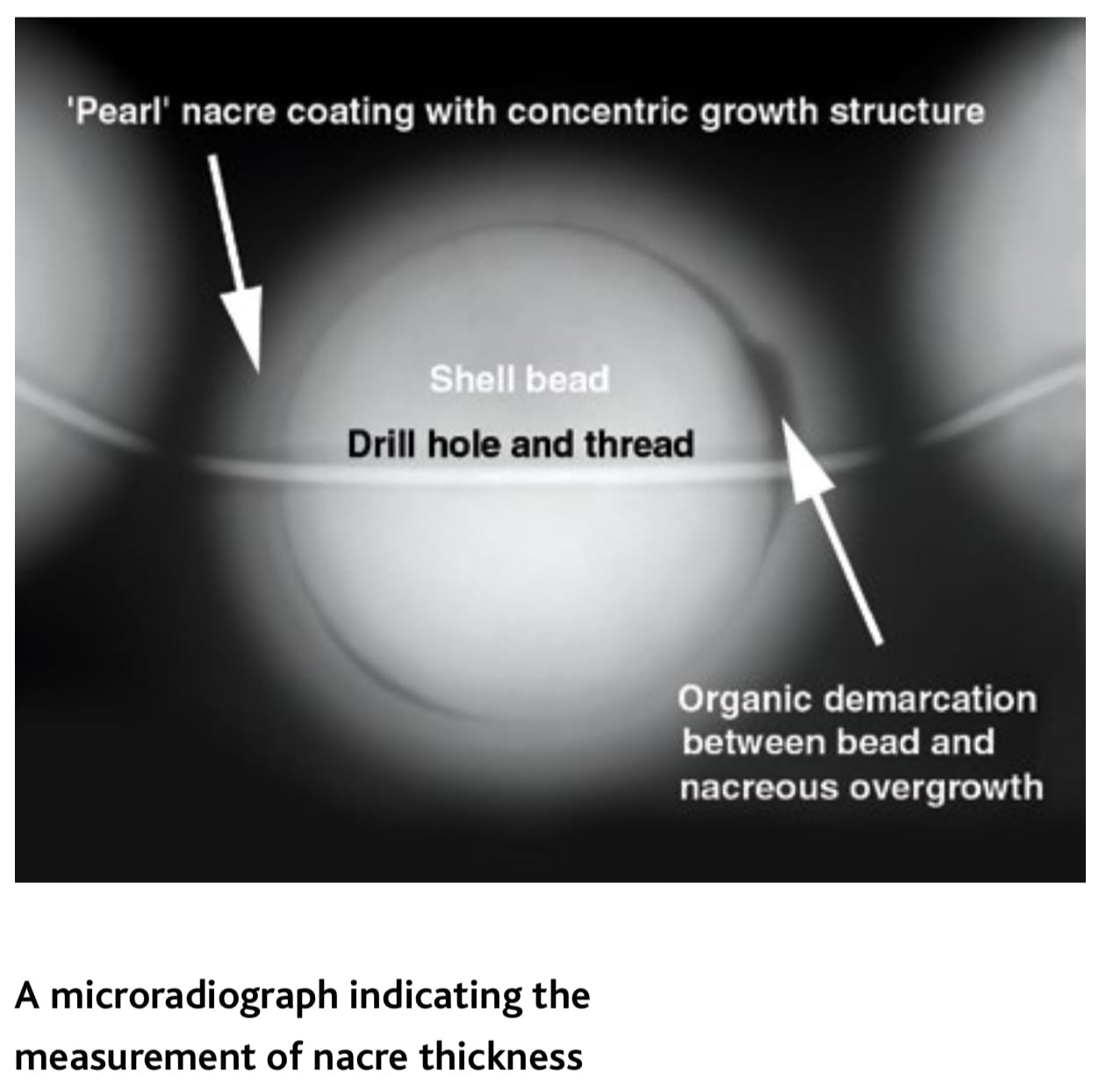Guide to Pearls

Types of pearls
Pearls may be natural (nacreous or non-nacreous) or cultured (nacreous or non-nacreous), come from either salt-water or freshwater mollusks. They may come in a variety of colors, shapes and sizes and may be suitable to be strung in the form of necklaces or set in jewelry. Other important pearls have had significant collector potential and have become the centerpiece of displays in museums and personal collections throughout the world.
Natural pearls
Almost any mollusk can produce a natural pearl. Natural pearls form accidentally within naturally formed pearl sacs in the interior of mollusks without interference from man. Mollusks are invertebrates with a soft unsegmented body, usually protected by a shell in one, or two, pieces. Natural pearls occur in two basic forms: whole pearls and blister pearls. Natural Blisters also occur.
Natural pearls may be nacreous or non- nacreous and come from either salt-water or freshwater mollusks.
Whole natural pearls
Pearls accidentally formed in a naturally formed pearl sac within mollusks without assistance from man. A naturally formed pearl-sac is derived from the internal or external layer of the epithelium of the mantle or of the gill plates. The epithelial cells of the pearl-sac secrete the nacre (or non-nacreous material) which becomes deposited over a foreign body (often too small to resolve), forming a pearl over time. Their entire surface is covered with nacre or non-nacreous material
Natural blister pearls
Pearls found attached to the inner surface of mollusk’s shell and formed without assistance from man. They first form as natural pearls in a naturally formed pearl sac, then break the sac to attach to the surface of the shell, where the host mollusk covers their surface with further layers of nacre or non-nacreous material.
Natural blister
Nacreous or non-nacreous protuberance accidentally formed on the inner surface of the mollusk shell without any assistance from man. They commonly originate from the intrusion of a foreign material into a space between mantle and inner surface of the nacreous or non-nacreous shell, or the repair of a hole in the shell bored by the intrusion of a sponge, parasite or similar.
Cultured pearls
Cultured pearls are formed in mollusks with the assistance of man. This human intervention should only involve the insertion of a piece of mantle tissue from another mollusk (usually of the same species) on top of a shell bead placed in the gonad (most saltwater mollusks) or into the mantle (freshwater mollusks) from which a cultured pearl sac is produced and which in turn secretes nacre (the substance normally produced by a mollusk to form the shell or a natural pearl. Cultured pearls occur in three basic forms, the whole-round cultured pearl (which may be either beaded or non-beaded), cultured blister pearls and cultured blisters.
Whole-round cultured pearl
Cultured pearls form in a cultured pearl sac within a mollusk with the assistance of man. Human intervention only gives rise to the formation of the cultured pearl sac and the introduction of a shell-bead (in the case of beaded cultured pearls). Whole round cultured pearls are classified into beaded cultured pearls and non-beaded cultured pearls.
Bead cultured pearl
Cultured pearls formed in a cultured pearl sac within a mollusk by inserting a piece (or pieces) of epitherial (mantle) tissue and a bead (or beads) usually made from a freshwater shell. Bead (or beads) are entirely covered with nacre secreted by the cultured pearl sac.
Non-beaded cultured pearls
Cultured pearls formed in a cultured pearl sac within a mollusk by inserting a piece (or pieces) of epitherial (mantle) tissue. They are entirely composed of nacre secreted by the cultured pearl sac.
Cultured blister pearls
Cultured pearls formed on the inner surface of mollusk shell with the assistance of man. They form as whole cultured pearls in a cultured pearl sac; they then break from the cultured pearl sac to attach to the surface of the shell, where the host mollusk covers their surface further with nacre.
Cultured blister (Hankei cultured pearls)
Pearls formed on the inner surface of the shell of mollusks by attaching a hemispherical (including three-quarter) object (or objects). The entire surface of the object (or objects) is covered with nacre secreted by mollusks.
Imitation pearls
Imitation pearls are artificial products not formed within (natural or cultured) pearl sacs or in mollusks but manufactured by man to imitate the appearance, color and other features of natural or cultured pearls.
Natural pearls
History
Many historical documents show that mankind has used natural pearls as ornaments since long before the beginning of the Christian era. In about 4,000 BC, the Indian Ocean, the Red Sea and the Gulf were famous for being a rich source of natural pearls. In addition, many European countries produced freshwater natural pearls.
In the New World, after the discovery of America by Columbus, numerous salt-water natural pearls were fished, especially in Venezuelan and Mexican waters. From the 1930s the nacreous natural pearl market contracted, largely related to a combination of the great depression, the discovery of oil in the Arabian Gulf and the appearance of cultured pearls.
Natural pearls today
Currently, most pearls sold are cultured, but natural pearls are still available in the markets of the Gulf and India as well as south-east Asia in general, Australia and the USA. In addition, natural pearls can be viewed in sumptuous royal or museum collects and purchased in the higher end jewelers and certainly can regularly be found in major auction sales.
Queen Conch pearl
Conch pearls are produced by a gastropod commonly known as the “Queen” or “Giant conch” (Lobatus gigas also known as Strombus gigas) that inhabits Caribbean waters. Conch pearls differ from ordinary nacreous pearls by having a tough crossed lamellar micro- architecture that manifests itself as a flame-like structure that appears to move as “watered-silk” when the pearl is moved under light. Queen conch pearls may also be cultured, but generally they are natural and come in a variety of colors. Some imitations are attempted by cutting the thick shell into beads.
Horse conch
The Horse conch pearl is a natural pearl produced by the Horse conch (Triplofusus papillosus also known as Pleuroploca gigantea), a very large gastropod inhabiting Caribbean and Indo-Pacific waters. It has an orange to reddish brown color and possesses a unique surface pattern.
Melo pearl
Melo pearls are produced by the large volute with the genus Melo, inhabiting the South China Sea, the waters around Australia, the Philippines, the eastern coast of Indonesia and the Andaman Sea. In Taiwan, Malaysia, Indonesia China and Vietnam they are caught for food.
Melo pearls are usually spherical and quite large but can also be baroque, they have a yellowish brown to orange and orangish-brown color. Like the Conch pearl and Horse conch pearl, Melo pearls do not have a nacreous structure but instead a crossed lamellar micro- architecture. The species known to have produced natural pearls are Melo broderipii, Melo Amphora and Melo melo.

Natural freshwater pearls
Most of the natural freshwater pearls on sale today are from the United States, they are obtained as a by- product of mussels from Unionidae collected as material to make pearl culturing beads. (mostly used for saltwater pearl cultivation). Among pearls gathered, those with interesting shapes such as “Wing” and “Rose bud” and exceptional colors are preferred.
In addition, natural freshwater pearls are found in rivers throughout Europe, the UK and Ireland.
Abalone pearl
Abalone is a gastropod of Haliotis widely inhabiting Pacific, Atlantic and Indian Oceans. The population is particularly rich along the coastal areas of Japan, North America and Australia. Though abalone pearls are popular, round examples are very rare, many are horn-shaped.
Cultured pearls
History
The modern cultured pearl industry started with Mikimoto’s hemispherical cultured pearl in 1893. In 1907 the technique of spherical or whole pearl culturing was developed. Since then, the cultured pearl industry has grown significantly. Pearl culturing areas have been extended, and in addition to the Akoya pearl oyster other species such as Silver/Gold lipped pearl oyster, Black lipped pearl oyster, the abalone and (in freshwater) the Triangle mussel are used.
Pearl culturing methods
At present three culturing techniques are used: bead pearl culturing, non-bead pearl culturing and the hemispherical or “Hankei” cultured blister.
Beaded cultured saltwater pearl
Based on Nishikawa’s “Piece method”, a bead (or beads) and ‘piece’ (or pieces) of mantle tissue from a sacrificed mollusk usually of the same species (the ‘piece’ eventually forming the ‘cultured pearl sac’ which secretes nacre over the entire surface of the bead) are inserted into the gonad of the host mollusk. Most salt- water cultured pearls are beaded.
Non-beaded cultured pearl
A piece (or pieces) of mantle tissue is inserted into a pocket (or pockets) in the mantle of a mussel (the ‘piece’ eventually forming the ‘cultured pearl sac’ which secretes nacre inwards on empty space). Most of freshwater cultured pearls are non-beaded.
Cultured blister (Hankei)
A hemisphere or three-quarter object) is placed on the inner surface of the shell and over time this is covered with nacre from the mantle of the host mollusk. Cultured blisters of this type are usually produced by using the Mabé pearl oyster (Pteria penguin) and Pteria sterna), as a result cultured blisters are also called Mabé cultured blisters.
Black-lipped pearl culturing
French Polynesia is the main country for producing black cultured pearls using the Black-lipped pearl oyster. However, culturing areas are expanding to Fiji, New Caledonia, and the Cook Islands. Recently smaller-sized black cultured pearls of below 10mm are on the increase.

Akoya cultured pearls
Cultured in Japan, China and Vietnam using Akoya oysters (Pinctada fucata (martensii)). Compared with other “pearl oysters”, the Akoya oyster is rather small; hence the size of pearl produced is usually less than 10mm. The most popular sizes are 6 and 7mm. Most of them contain a bead cut from the inner shell of a freshwater mollusk, although non-beaded examples are becoming more available.
Silver / Gold-lipped cultured pearls
Cultured in Australia, Indonesia, Philippines and Burma using Silver / Gold- lipped pearl oysters (Pinctada maxima). Generally, Australia produces large sized high-quality cultured pearls of over 10mm while in Indonesia smaller sized cultured pearls of below 10mm are also produced. The Philippines produce many golden cultured pearls using Gold-lipped oyster. Most of them contain a bead cut from the inner shell of a freshwater mollusk, although non-beaded examples are becoming more available.
Pearl culturing and the mollusks
Black-lipped pearl culturing
French Polynesia is the main country for producing black cultured pearls using the Black-lipped pearl oyster. However, culturing areas are expanding to Fiji, New Caledonia, and the Cook Islands. Recently smaller-sized black cultured pearls of below 10mm are on the increase.
Freshwater pearl culturing
Modern freshwater pearl culturing began in 1924 in Lake Biwa, Japan. Though pearl culturing was forced to stop because of World War II, the production volume increased thereafter. Production began to decrease from 1980, and today has reduced to almost zero.
Chinese freshwater pearl culturing started in 1981 with the export of 600g pearls to Japan. At present, annual Chinese freshwater cultured pearl production exceeds 1,500 tons. By the improvement of culturing techniques, large, round and smooth-surfaced pearls are able to be produced. However, large volumes of middle to low quality pearls are appearing on the world markets.
Quality of the cultured pearl
Quality elements
Size
Sizes of cultured pearls are measured in millimeters (mm).
Size range is largely dependent on the mollusk species used in the process.
• Akoya cultured pearl: 2-10mm
• Silver/Gold-lipped and Black-lipped cultured pearl: 8-16mm
• Freshwater cultured pearl: 2-13mm., although larger have become available.
Shape
Perfectly round is highly valued. Shapes are divided into round, oval, drop, button, and baroque with various asymmetrical circlé versions.

Nacre thickness
The depth of nacre coating on top of the bead in bead cultured pearls. It has some impact of their color, luster and durability. X-rays are used to measure nacre thickness and assist in observing nacre quality.
Surface condition
The surface of a cultured pearl is examined in terms of the number, size, kind and location of the imperfections. In evaluating the surface of cultured pearls, imperfections are taken into account – whether the pearl has a clean surface, one spot or many spots.
Luster
Luster is defined by the quality of the reflected light. A lustrous pearl has a strong bright and sharp reflection. A low luster pearl is not bright, and its reflection is dull. Many cultured pearls are heavily polished.
Color
A pearl’s color contains three basic components, hue, tone and saturation. Color characteristics differ according to the mollusk species. Overtones or “orient” may be present.
Akoya cultured pearl
Size: 2 -10mm. 6 and 7mm are the most popular.
Shape: Round, semi-round, oval, button, drop, semi-baroque, baroque and circlé.
Nacre thickness: Minimum is around 0.3mm.
Color: Pink, green pink, silver pink, cream pink, white, green, cream, gold.
Silver/Gold-lipped cultured pearl
Size: Over 10mm is the most popular but smaller sizes (8, 9mm) are available.
Shape: Same as Akoya cultured pearl. Nacre thickness: Thick nacre
Color: Silver, silver pink, pink, grey, cream, golden and yellow.
Black-lipped cultured pearl
Size: Over 10mm is the most popular. Recently smaller sizes (8, 9mm) have appeared.
Shape: Same as Akoya cultured pearl. Nacre thickness: Thick nacre
Color: Black, green, brown, blue, grey, peacock, red.
Freshwater cultured pearl
Size: 3 to over 10mm
Shape: Round, semi-round, oval, rice, button, drop, baroque.
Color: Three basic colors (orange, purple and white).
Treatment of a pearl or cultured pearl
Treatment is any action by man (other than polishing, cleaning, buffing and peeling) that alters the appearance of a pearl or cultured pearl. The following treatments must be declared at the point of sale.
Bleaching: to remove, lighten or alter color by means of chemical and/or physical agents or light.
Coating: an artificial layer of any natural or artificial substance spread over the surface, of pearls for protection, coloration, increased luster and other optical phenomena, decoration or to change appearance; a covering layer.
Dyeing: any color caused artificially by the application of a dye to pearls.
Filling: a substance that occupies a whole or part of a void in a pearl.
Irradiation: exposing pearls or cultured pearls to radiation.
Luster enhancement: Any treatment or process applied to enhance the luster of a natural or cultured pearl.
Oiling: a process sometimes applied to natural and cultured pearls, whereby the surface of pearls is soaked in warm oil; to diminish the appearance of cracks.
Tinting: a treatment which causes a subtle change in color and/or appearance.
Waxing: the application of a colorless wax or similar products to, or near, the surface of a pearl.
Working: significantly remove layers of nacreous or non-nacreous material from a pearl, usually to remove blemishes and/or to reshape a pearl, especially blister pearls.
Source: CIBJO Retailer Reference Guide, cibjo.org.